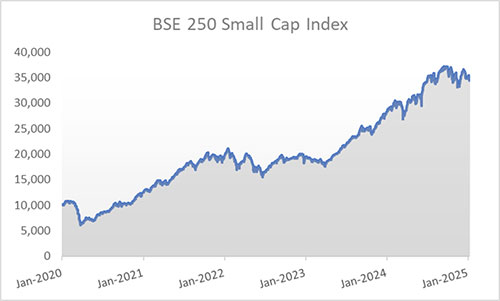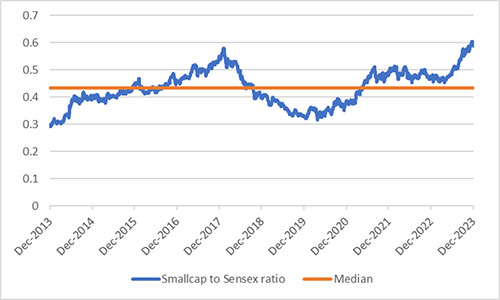Mutual Fund Returns in 2025: Will Small Cap Fund Dominance Sustain?
Divya Grover
Jan 08, 2025 / Reading Time: Approx. 10 mins
Listen to Mutual Fund Returns in 2025: Will Small Cap Fund Dominance Sustain?
00:00
00:00
Small Cap Funds have witnessed a spectacular run in the last five years. The significant upturn in the small-cap segment recent years has astonished even seasoned investors. Notably, the category generated 32.3% CAGR on an average in the last 5 years, much higher than the 17.2% CAGR fetched by Large Cap Funds.
Even though the Indian equity market has eased from its all-time high due to intense volatility in recent months, investors have continued to pour money into Small Cap Funds. The category even managed to restrict fall compared to large caps, highlighting their multibagger potential and rising interest in the segment.
The top-performing scheme on a 5-year return basis offered CAGR of a whopping 47%, while the bottom-performing scheme delivered 24.5%. Notably, the benchmark Nifty Smallcap 250 - TRI index grew by 30% during this period.
Buoyed by the optimism, investors bet heavily in this space. AUM of Small Cap Funds rose from Rs 51,161 crore as of January 31, 2020 to Rs 3,18,281 crore as of November 30, 2024, growing by an impressive six times. Number of folios rose nearly 5 times from around 50 lakh to 2.4 crore during this period.
[Read: Here's What Mutual Fund Folio Data Reveals About Investor Behaviour]
Small-cap stocks witnessed stellar growth in the last few years
 Past performance is not an indicator for future returns
Past performance is not an indicator for future returns
Data as of January 06, 2025
(Source: ACE MF, data collated by PersonalFN)
Now the question arises whether the outperformance in the small-cap segment continue in 2025 or should investors brace for a market correction?
First let's us find out the factors driving the exuberance in the small-cap segment:
What is driving the stellar rally in the small-cap segment?
India retaining its tag as one of the fastest-growing economies in the world has been the main driver which attracted sustained domestic flows into the market, absorbing persistent selling by foreign investors. Additionally, the healthy balance sheet of corporates and banks, robust export orders, high capacity utilisation, continuing business optimism, and the government's thrust on infrastructure have boosted investor sentiments.
Moreover, a large number of novice investors have entered the equity segment after the market started recovering from the lows of Covid-19-induced crash of early 2020. The growing investor base too has been the key driver of optimism in the equity market.
What to expect from the small-cap segment in 2025?
Going ahead, market experts are positive about the broader market's bullish trajectory in 2025, supported by robust fundamentals of the corporate sector and the resilient growth of the domestic economy. However, a potential slowdown in global growth, geopolitical tensions, an uncertain inflation outlook, and weak consumption growth can temper the growth prospects.
[Read: Equity, Debt, and Gold - Performance Review and Investment Outlook for 2025]
As per RBI's latest Financial Stability Report, despite the recent correction, equity valuations across metrics such as trailing and forward price-to-earnings (P/E) ratios, market capitalisation-to-GDP, and earnings yield remain elevated. Stretched valuations are more prominent in mid-cap and small-cap stocks. To justify the current valuations for all indices, the required earnings growth should exceed the expected earnings growth to forestall a large and abrupt market correction.
Smallcap to Sensex ratio is at a peak
 Data as of January 06, 2025
Data as of January 06, 2025
(Source: ACE MF, data collated by PersonalFN)
It is noteworthy that the S&P BSE Smallcap to Sensex ratio, which is a key determinant of valuations in the small-cap segment, currently stands at a peak of 0.7, indicating a high premium and low margin of safety. It is worth noting that the ratio was at around 0.6 level just before the mid and small-cap crash of 2018-19. If the tables turn large caps could potentially outpace small caps in 2025.
Thus, investors should set realistic expectation of returns in 2025. It is also important to note that the equity markets are cyclical in nature and no market segment can outperform year after year - peaks are followed by downfalls, and vice versa. Small caps are usually not resilient during bearish market phases and tend to witness higher downside risk compared to mid and large caps.
Over the last few years an unprecedented amount of money has chased Small Cap Funds. However, numerous small-cap stocks do not have the capacity to handle exceptionally large trading volumes. In other words, small-cap stocks can face liquidity constraints. Small Cap Mutual Funds also find it challenging to invest the inflows worth crores they are getting each month amid stretched valuations. Not surprisingly, some mutual fund houses have restricted fresh inflows into their small-cap schemes, while a few others have decided to hold higher cash balance, underpinning the need for high caution when investing in Small Cap Funds.
[Read: 3 Best Small Cap Funds for 2025 - Top Performing Small Cap Mutual Funds in India]
How should investors approach Small Cap Funds now?
While the extraordinary upswing in mid and small-cap stocks has been exciting for investors, it has raised lots of questions and concerns. Investors are thrilled with the gains, but they are also concerned about the stretched valuations and a potential market correction.
So, deciding what to do with the small-cap investments comes down to three key things:
1. Your Financial Goals: When making investment decisions, consider your financial goals which will help you design the right investment plan and shortlist suitable schemes. So, carefully decide what you want to achieve with your money. If you are looking to build substantial wealth over many years and are willing to adopt an aggressive strategy to achieve the said goal, you might consider holding or adding exposure to Small Cap Funds. For investors looking to tap the high potential of lesser-known but high-growth companies then small caps can be a suitable choice. But if your goal is to earn steady returns at reasonable risk then Small Cap Funds may not fit the bill.
[Read: How to Set Achievable Financial Goals And Plan to Achieve Them]
2. Your Risk Profile: Everyone has a different comfort level when it comes to dealing with the ups and downs of investments. If you are a long-term investor with a high risk tolerance and are comfortable with the idea of your small-cap investment values witnessing significant fluctuations in the short term, you might want to consider holding onto them or even buying more of them. If you are risk-averse and not comfortable with those short-term movements, you might think about reducing the exposure to your high-risk mid and small-cap investments by selling some of them and rebalancing your portfolio by including more large caps that tend to be less risky.
[Read: How to Assess Your Risk Profile for Investments?]
3. Your Time Horizon: The time horizon to goal simply means how long you plan to stay invested before you need it for the set purpose. If your set financial goals are at least 5-7 years away, you may incline towards sticking with a 'hold' or 'buy' strategy because you have time to ride out market ups and downs. On the other hand, if you need your money in the short term, say within a year or two, you might lean toward selling some of the mid and small-cap stocks to lock in profits or limit potential losses. Think long-term and avoid chasing quick gains or getting worried when the market moves up and down.
To summarise, you should think carefully about what you want to do with your money, how much risk you are comfortable with, and how long you plan to stay invested.
Conclusion
Investors need to be cautiously optimistic when approaching Small Cap Funds in 2025. They should avoid getting carried away by the exuberance seen in recent years as past performance is not an indicator of future. In case the market witnesses a correction in the near term, the downside could be higher in the case of mid and small-cap stocks as the valuation in the segment appears to be overstretched. Meanwhile, large caps can provide better stability and downside protection.
Also, don't live under the impression that earnings would improve linearly quarter-on-quarter. The equity market cannot continue to scale new highs on irrational expectations and exuberance, particularly when there are ostensible clouds of global economic uncertainty and geopolitical tensions.
Investors should diversify their portfolio keeping the risk-reward ratio in mind. Carefully select equity mutual funds that align with your investment objectives, risk profile, and investment horizon to avoid undue risks.
Watch this video to know about the risks to watch out for when investing in Small Cap Funds:
We are on Telegram! Join thousands of like-minded investors and our editors right now.
DIVYA GROVER is the co-editor for FundSelect, the flagship research service of PersonalFN. She is also the co-editor of DebtSelect. Divya is an avid reader which helps her in analysing industry trends and producing insightful articles for PersonalFN’s popular newsletter – Daily Wealth letter, read by over 1.5 lakh subscribers.
Divya joined PersonalFN in 2019 and has since then used stringent quantitative and qualitative parameters to analyse funds to provide honest and unbiased research to investors. She endeavours to enable investors to make an informed investment decision and thereby safeguard their wealth.
Disclaimer: Investment in securities market are subject to market risks, read all the related documents carefully before investing.
This article is for information purposes only and is not meant to influence your investment decisions. It should not be treated as a mutual fund recommendation or advice to make an investment decision in the above-mentioned schemes.